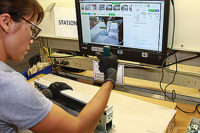Visual Communication for Tool Crib Management










“Employee theft is an epidemic that directly reduces bottom-line profitability,” says Lee Schwartz, principal of the Schwartz Profitability Group, a management consulting firm. “Dark, less accessible areas of the factory are prime areas in which product will disappear. Same goes for inventory near exit doors.”
When an assembler can’t do his job because an important tool is missing, your plant can’t meet its production goals. “No one wants to stop production and change schedules because tools aren’t available,” adds Maury Leman, president of Saltbox Systems Group Inc., a supplier of tool tracking software.
Coping with security, inventory and damaged goods is a way of life for tool crib managers, the unsung heroes of the industrial workplace. Tool crib managers are responsible for hundreds of thousands of dollars worth of tools. They maintain inventory, verify receipts for purchases, monitor spare parts, and drive forklift trucks. They must lift 75 pounds safely, repair and recalibrate tools, and demonstrate excellent organization, customer service and communication skills.
With hundreds of workers spread out over multiple shifts, the tool crib manager is busy. While no two cribs are exactly alike, they all share a need for improved organization, whether it’s to prevent theft or manage inventory.
Shelves, drawers, cabinets, locks and hooks are used to store and organize tools, which range from screwdrivers to sophisticated calibration and test equipment. Some tool cribs look like ordinary offices. Others are oversized cages.
In an assembly plant, a tool crib is typically a separate room with access limited to a handful of people. During off-shifts, selected foremen may have keys to the crib. Larger facilities might have several tool cribs.
Managers run tool cribs in different ways, depending how many tools need to be tracked, which kinds of tools need to be tracked, how many shifts are employed at the plant, who has access to the tool, and whether tools stay on site or go off site.
“Securing the space, taking frequent inventory counts, and getting accounting departments to charge losses to users are three ways tool crib managers can reduce theft and increase security,” offers Don Benson, The Warehouse Coach.
Using Visual Communications
High-performance labeling supplies can help tool crib managers sort, manage and identify tools. For example, scannable bar code labels are widely used in tool cribs. These labels are available in multiple high-contrast colors, enabling managers to both color-code and bar-code tools using the same label. The labels are made with an aggressive adhesive that will last for years in heavy industrial applications. For even greater protection, a thin, clear film can be placed over the label.
“All our items are identified with bar code labeling. Tool cribs are physically secured and all items issued are scanned to an employee’s identification badge,” says Danny Smalley, an engineer with Gulfstream Aerospace Corp.
Using a thermal transfer printer, managers can print black-and-white employee identification photos on clear or white vinyl sheets.
Magnetic labels are movable and durable. Tool crib managers can create custom labels, apply them to metal drawers or shelves, and then just lift up the label when needed.
Tamper-proof and tamper-evident destructible tapes are also worth noting. Some tamper-evident tapes have the word “VOID” permanently printed on the label’s adhesive. If the label is peeled off, the adhesive will leave a lasting mark on the surface. This prevents labels from being reused.
Embossable poly tape is specially engineered to provide extra protection for labels requiring handwritten information. Once marked with a ballpoint pen, this tape retains a written impression—even after the ink has faded. A silver metalized film provides a strong and attractive canvas for displaying both printed and handwritten information. Embossable poly tape is also used for inspection labels, form labels, security labels, quality assurance labels and other asset management applications where written information must be protected from alterations.
The most common labeling supply is vinyl tape. Several types of vinyl tape are available in multiple colors that are perfect for identifying shift teams, hard hats and tools.
Crib Management Strategies
There are three strategies for managing tool cribs:
- Free to roam. Believe it or not, some companies have a free-to-roam system. If you need a tool or a part, you just go in and get it. This can get a little out of hand, so some plants give keys to only a select few.
- Stocked and locked. Only tool crib clerks have access to the tools.
- Count the inventory. Some companies count their tool inventories three to five times a week.
- Technology is making its way into facilities, too. More and more facilities are using automated tool crib vending machines and inventory tracking software. Tool crib management software from Saltbox Systems enables users to:
- Monitor the locations of tools.
- Leverage bar codes to link tool crib transactions with inventory control.
- Gauge stock levels.
- Keep on top of maintenance records.
What will the tool crib of the future look like? From a visual communication perspective, expect to see mobile print stations, touch screen monitors, all inclusive OSHA-ANSI compliant software, and rugged supplies that will perform under the harshest conditions.
For more information on visual management aids, call Graphic Products at 800-788-5572, ext. 5683, send an e-mail to mcarter@graphicproducts.com, or visit
www.duralabel.com.
For more information on tool tracking software, call Saltbox Systems at 941-284-3697 or visit www.saltboxsystems.com.
Looking for a reprint of this article?
From high-res PDFs to custom plaques, order your copy today!










